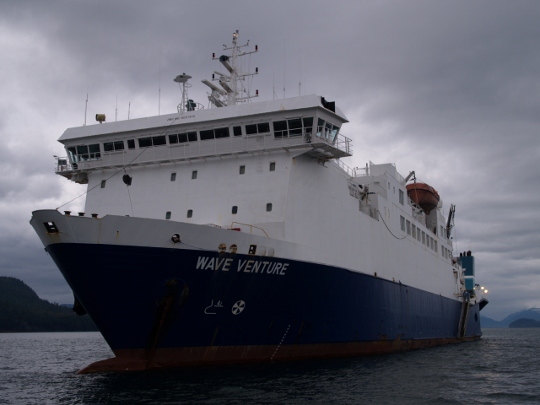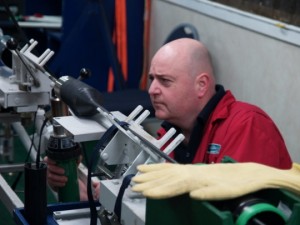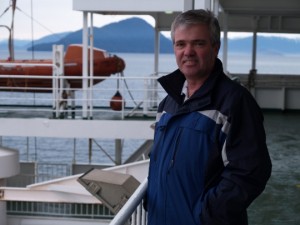Click here for iFriendly audio.
There are thousands of miles of fiber optic cables snaking along the ocean floor. They bring telephone service, television, and the internet to much of world.
When an earthquake struck off the coast of Southeast Alaska in January, the cables that provide Internet to Wrangell were damaged. A cable repair ship, called the Wave Venture, was called to help.
The Wave Venture is anchored off the coast of Wrangell Island. From shore, she looks large enough anchored in the water. But up close, she’s enormous, a re-purposed ferry that’s been converted into a cable repair ship.
We pull up alongside her massive blue and white hull. The ship’s crew lowers a set of grated metal stairs so the other visitors and I can climb up her expansive side to the main deck.
The deck is long and clean. Each piece of equipment seems to have its place.
I meet up with Captain Kevin Widdowson. He’s wearing a navy blue jacket and smiling. As we walk, he neatly steps over the piles and lines of thick, black, ropey cords that criss-cross the deck.
“This is cable. This is your fiber optics. Every time you press dot com on your PC, this is where it goes through…Everybody seems to think that it’s all microwave and satellite driven, and it’s quite the opposite, really,” says Widdowson.
He points to the walls and ceiling where there’s even more cable hanging from loops and hooks.
We look down over a safety railing into the hull of the ship. There are thousands of miles of cable coiled in thick beehive stacks higher than a person.
He tells me it’s important for the ship to be fully stocked and ready to go out on a call 24 hours a day, 7 days a week.
“When people can’t log on or they can’t send their emails, they start complaining. So it’s up to us to get onto the seabed and sort it out,” says Widdowson.
When there’s a problem, the Wave Venture leaves its port in Victoria, British Columbia and heads out to do the repair. This ship is responsible for the thousands of miles of cable that stretch from Canada through Alaska, out to Hawaii, and all the way down to Mexico.
We head into the cable repair shop, where technicians cut, mend, and splice damaged fiber optic lines. Two men in identical orange jumpsuits are bent over a shiny silver tube that houses a piece of cable damaged in the last earthquake. Nick Corbett is a jointing systems technician.
The crew prefers to use a Remote Operated Vehicle to retrieve the cable. But the water was too murky. The captain guesses a lot of silt may have been kicked up during the earthquake.
So, Widdowson says, they had to leave technology behind and turn to a more traditional method called grapnelling.
“This is what the old-style ships had, and still have, for cable recovery. This is as simple as it gets. It’s just bits of iron, bits of ironwork chained together, and we drag that across the seabed. And, it hooks the cable. The cable comes into the mouth of the grapnel. And we just monitor the tension. And when the tension starts to rise, then we know that we’ve grabbed something,” says Widdowson.
There are several grapnels on the deck. Some are the size of tires, others are smaller and more delicate. One is half the size of a person and has four enormous curved spikes for dragging on the sea floor.
“And the one that we found success with on this particular job is this monster of a grapnel here. We call it Son of Sammy,” says Widdowson.
He says it comes from an old sea legend, but that story’s for another time. He explains that grapnels are the only technology they can count on to work in even the worst conditions.
“But which date back to Brunel’s time—Isambard Kingdom Brunel and his ship, the Great Eastern, when they laid the first cable across the Atlantic. And we’re still using some of those methods here today. The history of cable ships is absolutely enthralling,” says Widdowson.
In the end, it took the Wave Venture five days to get Wrangell’s services up and running. After that, they headed back to Victoria, to wait for the next call.
To hear this story as it was featured on AK from Alaska News Nightly and APRN, click here.
To see more photos from the Wave Venture, click here, or visit our Facebook page.
















